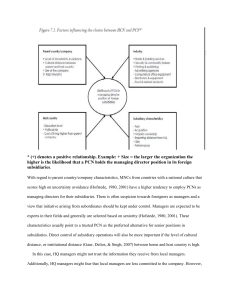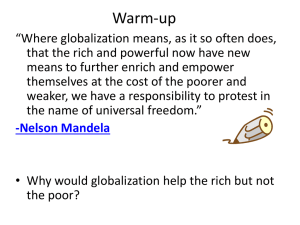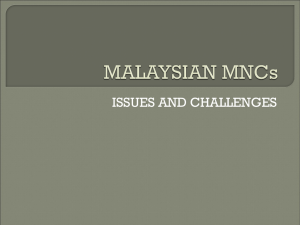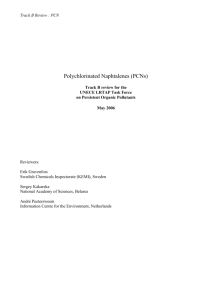IHRM: SUSTAINING INTERNATIONAL BUSINESS OPERATIONS
advertisement
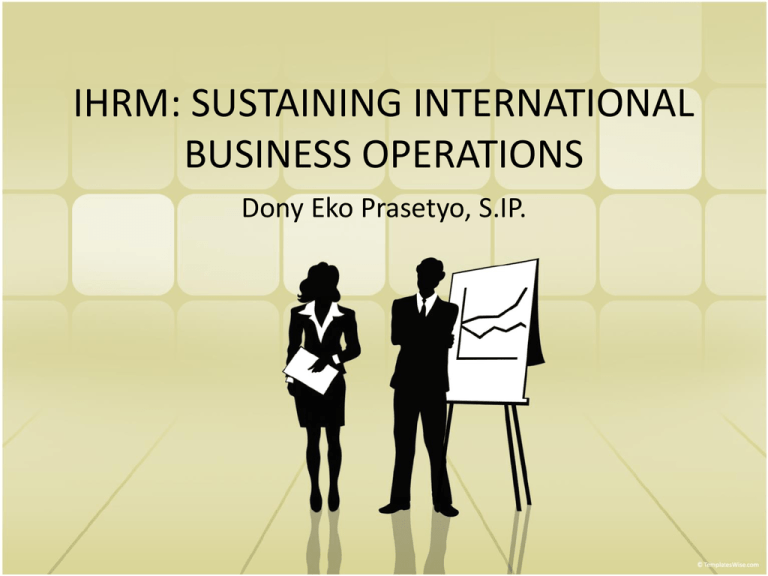
IHRM: SUSTAINING INTERNATIONAL BUSINESS OPERATIONS Dony Eko Prasetyo, S.IP. Globalization Involves Us All We experience international transactions daily Imports and exports reach even remote areas Technology and e-biz promote trade Consumers and companies pull markets closer Globalization Trend toward greater economic, cultural, political and technological interdependence among national institutions and economies Globalization of markets Convergence in buyer preferences in markets around the world Globalization of production Dispersal of production activities worldwide to minimize costs or maximize quality Benefits of Globalization Globalization of markets Globalization of production • Reduces marketing costs • Access lower-cost labor • New market opportunities • Access technical expertise • Levels income stream • Access production inputs Challenges to Business Physical security Digital security Reputational risk Examine company vulnerability and create a disaster recovery plan Guard proprietary information and confidential communications Require ethical and lawful behavior from all employees and business partners Globalization Drivers I Remove barriers to trade and investment GATT WTO Regional trade agreements Trade Exceeds Output Globalization Drivers II Technological Innovation Email and videoconferencing Better coordination and control Internet, intranets, and extranets Transportation advancements Improved communications and management More efficient, dependable shipping Measuring Globalization Globalization Then and Now Highly mobile labor market Fear of jobs moving abroad Free-flowing capital and trade Backlash among the disaffected Global Business Environment International Business International Business Players Multinational Corporation Small Businesses and Entrepreneurs Small companies and Business that has direct individuals becoming investments abroad in increasingly active in multiple countries international trade and investment Born Global Firm Adopts a global perspective and engages in international business from or near its inception International Business Defined International business: all commercial transactions between parties in two or more countries – Private firms are profit-oriented. – Government organizations may or may not be profit-oriented. The international business environment is more complex and diverse than the domestic business environment. Fig. 1.1: International Business: Operations and Influences Reasons That Firms Engage in International Business • To expand sales • • • • • • • Volkswagen [Germany] Ericsson [Sweden] Michelin [France] Nestlé [Switzerland] IBM [USA] Seagram [Canada] Sony [Japan] • To acquire resources • • • • Products, components, services Foreign capital Technologies Information • To minimize risk • Take advantage of business cycle differences amongst countries • Diversify suppliers across countries • Counter competitors’ advantages Modes of Entry into International Business • Merchandise exports and imports • Service exports and imports • Use of assets [licensing agreements] • [Foreign investment] – Foreign direct investment – [Portfolio investment] Means for Conducting International Operations International Business Terminology • Strategic alliance: a collaborative arrangement of critical importance to one or more of the alliance partners • Multinational enterprise [MNE]: a firm that takes a global approach to its foreign markets and production Multinational corporation [MNC] and transnational company [TNC] may be used in this same context. International Business Managers • Must understand the relevance of: – – – – – – – Domestic and international law Political science Anthropology Sociology Psychology Economics Geography • Must be knowledgeable about the competitive dimensions of the international business environment Physical and Societal Influences on International Business Competitive Factors Affecting International Business Approaches to Staffing • Factors affecting approaches to staffing – General staffing policy on key positions at headquarters and subsidiaries – Constraints placed by host government – Staff availability Ethnocentric Polycentric Geocentric Regiocentric Ethnocentric • Strategic decisions are made at headquarters; • Limited subsidiary autonomy; • Key positions in domestic and foreign operations are held by headquarters’ personnel; • PCNs manage subsidiaries. Ethnocentric Approach Advantages: To ensure new subsidiary complies with overall corporate objectives and policies Has the required level of competence Assignments as control Disadvantages: Limits the promotion opportunities of HCNs, leading to reduced productivity and increased turnover among the HCNs Longer time for PCNs to adapt to host countries, leading to errors and poor decisions being made High cost Considerable income gap, high authority, and increased standard of living may relate to lack of sensitivity Polycentric • Each subsidiary is a distinct national entity with some decision-making autonomy; • HCNs manage subsidiaries who are seldom promoted to HQ positions; • PCNs rarely transferred to subsidiary positions. Polycentric Approach Advantages: Employment of HCNs eliminates language barriers, avoids adaptation of PCNs, reduces the need for cultural awareness training programs Employment of HCNs allows a multinational company to take a lower profile in sensitive political situations Employment of HCNs is less expensive Employment of HCNs gives continuity to the management of foreign subsidiaries (lower turnover of key managers) Disadvantages: Difficult to bridge the gap between HCN subsidiary managers and PCN managers at headquarters ( language barriers, conflicting national loyalties, cultural differences) HCN managers have limited opportunities to gain experience outside their own country PCN managers have limited opportunities to gain international experience Resource allocation and strategic decision making will be constrained when headquarter is filled only by PCNs who have limited exposure to international assignment Geocentric • A global approach - worldwide integration; • View that each part of the organization makes a unique contribution; • Nationality is ignored in favor of ability: – Best person for the job; – Color of passport does not matter when it comes to rewards, promotion and development. Geocentric Approach Advantages: Ability of the firm to develop an international executive team Overcomes the federation drawback of the polycentric approach Support cooperation and resource sharing across units Disadvantage: Host government may use immigration controls in order to increase HCNs employment Expensive to implement due to increased training and relocation costs Large numbers of PCNs, HCNs, and TCNs need to be sent across borders Reduced independence of subsidiary management Geocentric Staffing Requirements Regiocentric • Reflects a regional strategy and structure; • Regional autonomy in decision making; • Staff move within the designated region, rather than globally; • Staff transfers between regions are rare. Regiocentric Approach • Advantages: Allow interaction between executives transferred to regional headquarters from subsidiaries in the region and PCNs posted to the regional headquarters Provide some sensitivity to local conditions Help the firm to move from a purely ethnocentric or polycentric approach to a geocentric approach • Disadvantages: Produce federalism at a regional rather than a country basis and constrain the firm from taking a global stance Staff’s career advancement still limited to regional headquarters, not the parent country headquarters The advantages and disadvantages of using PCNs, TCNs and HCNs Determinants of IHRM approaches and activities Reasons for international assignments • Position filling – Eg. Skills gap, launch of new endeavour, technology transfer • Management development – Training and development purposes, assisting in developing common corporate values • Organizational development – Need for control, transfer of knowledge, competence, procedures and practices Types of international assignments • Short term – Up to 3 months • Extended – Up to 1 year • Long term – Varies from 1 to 5 years – The traditional expatriate assignment Non-standard assignments • • • • Commuter assignments Rotational assignments Contractual assignments Virtual assignments Some of these arrangements assist in overcoming the high cost of international assignments but are not always effective substitutes for the traditional expatriate assignment Factors influencing virtual assignments Roles of an expatriate • • • • • • Agent of direct control Agent of socialization Network builder Boundary spanner Language node Transfer of competence and knowledge The roles of an expatriate The role of non-expatriates • People who travel internationally yet are not considered expatriates as they do not relocate to another country – Road warriors, globetrotters, frequent fliers • Much of international business involves visits to foreign locations, eg. – Sales staff attending trade fairs – Periodic visits to foreign operations A glamorous life? • International business travelers cite the positives as: – Excitement and thrills of conducting business deals in foreign locations – Life style (top hotels, duty-free shopping, business class travel) – General exotic nature But a high level of stress! • Home and family issues – frequent absences • Work arrangements – domestic side of position still has to be attended to • Travel logistics – waiting in airports, etc. • Health concerns – poor diet, lack of sleep, etc. • Host culture issues – limited cultural training Various roles of corporate HR The role of the corporate HR function • Can we manage our people like a global product? The feasibility of: – The concept of a global internal labour market – Standardization of work practices and HR activities • What HR matters require central control and what can be decentralized?




